I love living in New York City, where every borough has its own special vibe. Brooklyn, the biggest and most crowded borough, is a treasure trove of cultures and stories. A detailed map of Brooklyn’s neighborhoods is key to experiencing its rich history and lively present.
Whether you’ve lived here forever, just moved, or are just visiting, knowing Brooklyn’s neighborhoods is essential. You’ll find everything from hip spots in Williamsburg and Bushwick to family-friendly areas like Park Slope and Bay Ridge. The Brooklyn neighborhood map is your guide to the borough’s history, arts, food, and diverse communities.
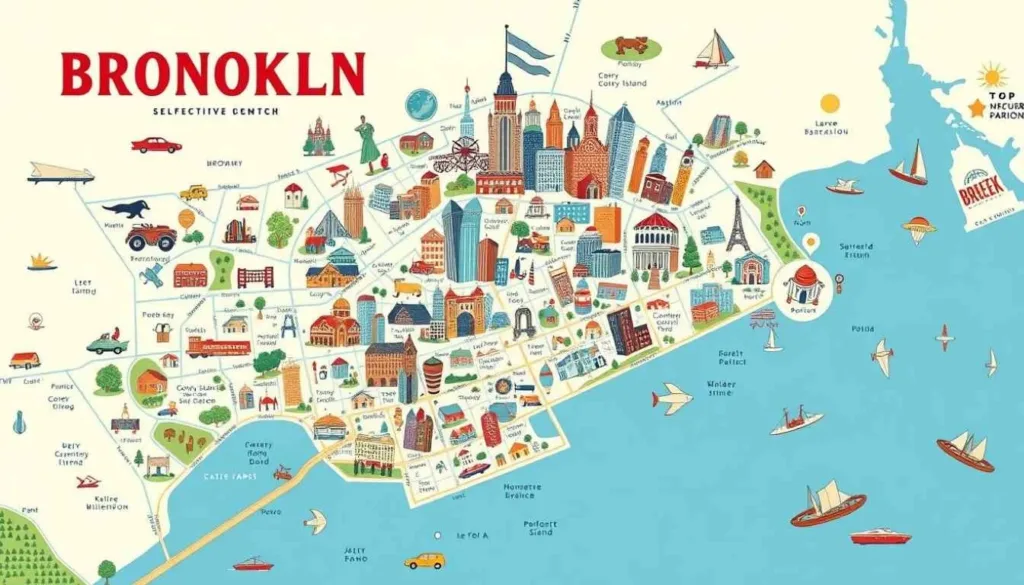
Key Takeaways
- Discover the unique character and diversity of Brooklyn’s neighborhoods
- Explore the historical significance and contemporary urban landscape of the borough
- Navigate the vibrant arts, culinary, and cultural scenes across different communities
- Gain insights into the evolution of Brooklyn’s neighborhoods over time
- Plan your exploration of New York City’s largest and most populous borough
Introduction to Brooklyn’s Rich Cultural Landscape
Brooklyn is a vibrant and diverse borough in New York City. It has a fascinating history that spans centuries. From its Dutch roots to today’s cultural melting pot, Brooklyn’s story is one of resilience and celebration of cultural diversity.
From Dutch Roots to Modern Diversity
The story of Brooklyn begins in the 17th century. The Dutch and Lenape people first settled here. Over time, immigrants from all over the world have made Brooklyn their home. Each group has added to the unique neighborhood character of the borough.
- Dutch settlers established the first permanent European settlement in Brooklyn in 1624, laying the foundation for the borough’s development.
- Successive waves of immigration, including Irish, Italian, Jewish, and Caribbean communities, have shaped the cultural landscape of Brooklyn.
- Today, Brooklyn is a vibrant tapestry of ethnicities, religions, and traditions, celebrating its rich cultural diversity.
Brooklyn’s Evolution Through Time
The story of Brooklyn is one of continuous transformation. From rural townships to a thriving urban center, Brooklyn has changed a lot. Key historical events and developments have shaped its unique character and identity.
- The consolidation of New York City in the late 19th century brought Brooklyn into the fold, leading to rapid industrialization and population growth.
- The mid-20th century saw the emergence of iconic neighborhoods like Williamsburg and Bushwick, known for their artistic and cultural contributions.
- In recent decades, Brooklyn has undergone a remarkable transformation. Its revitalized waterfront, thriving arts scene, and vibrant culinary landscape attract many residents and visitors.
As Brooklyn continues to evolve, its rich cultural diversity remains a defining characteristic. This makes Brooklyn a truly unique and captivating destination within New York City.
Understanding Brooklyn Neighborhood Map: A Comprehensive Guide
Exploring the lively neighborhoods of Brooklyn is an exciting adventure. The map of Brooklyn is a key tool, showing the rich variety of this lively borough. Knowing each city neighborhood helps you appreciate Brooklyn’s culture and growth.
A detailed typography map of Brooklyn is a big help. It guides people through streets, landmarks, and community spots. By learning about the neighborhoods in Brooklyn, you can discover its charm, from Cobble Hill’s history to Williamsburg’s modern vibe.
If you live here or are new, a full map of Brooklyn is your best friend. It helps you find homes and cultural spots. This tool deepens your understanding of Brooklyn and inspires your next journey.
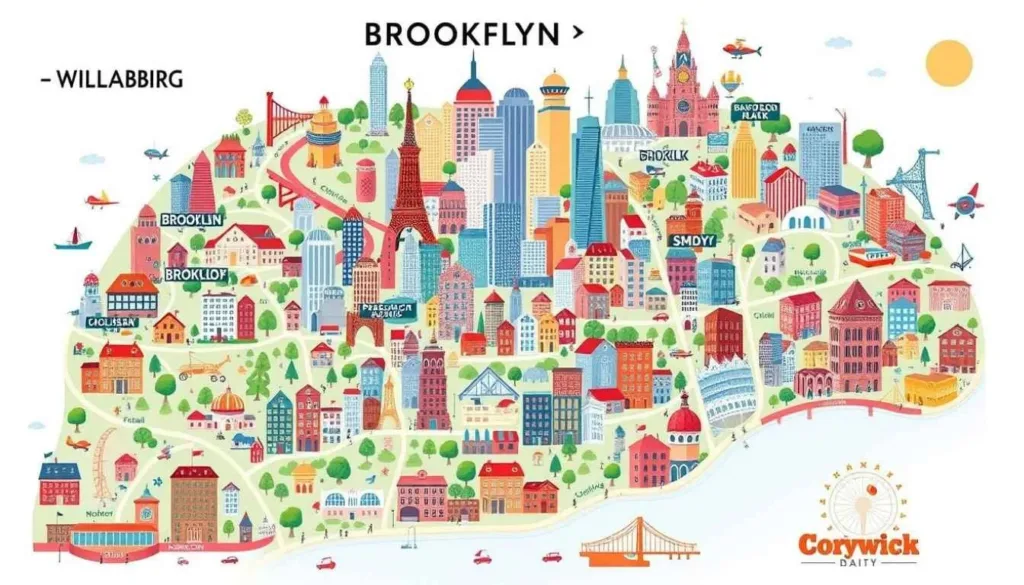
Exploring neighborhoods in Brooklyn reveals many stories. Each area adds its own chapter to the city’s story. Brooklyn Heights has a colonial past, while DUMBO and Bushwick are hubs for art today. The map of Brooklyn shows the borough’s ability to change and thrive.
Using a detailed typography map helps you connect with your neighborhood or new ones. Find hidden spots, learn about local life, and explore Brooklyn’s history. A good map is your guide to discovering it all.
Historical Development of Brooklyn’s Districts
Brooklyn, a borough in New York City, has a rich and diverse history. This history has shaped its unique neighborhoods. From colonial times to today, Brooklyn’s districts tell the story of how this community has grown.
Colonial Heritage and Urban Growth
Brooklyn started as Dutch colonial settlements. As more people moved in, these towns became busy cities. The Department of City Planning and community boards helped keep Brooklyn’s heritage alive while it changed with the times.
From Rural Townships to Urban Neighborhoods
The shift from rural to urban areas was tough. The borough of New York City grew fast, attracting many immigrants. This growth created different neighborhoods, each with its own culture and economy.
The Impact of NYC Consolidation
In 1898, Brooklyn joined New York City, becoming one of the five boroughs. This change deeply affected Brooklyn’s areas. The Department of City Planning and community boards worked to bring these communities together.
Today, Brooklyn is a lively and changing place. It shows the strength and flexibility of its people and places.
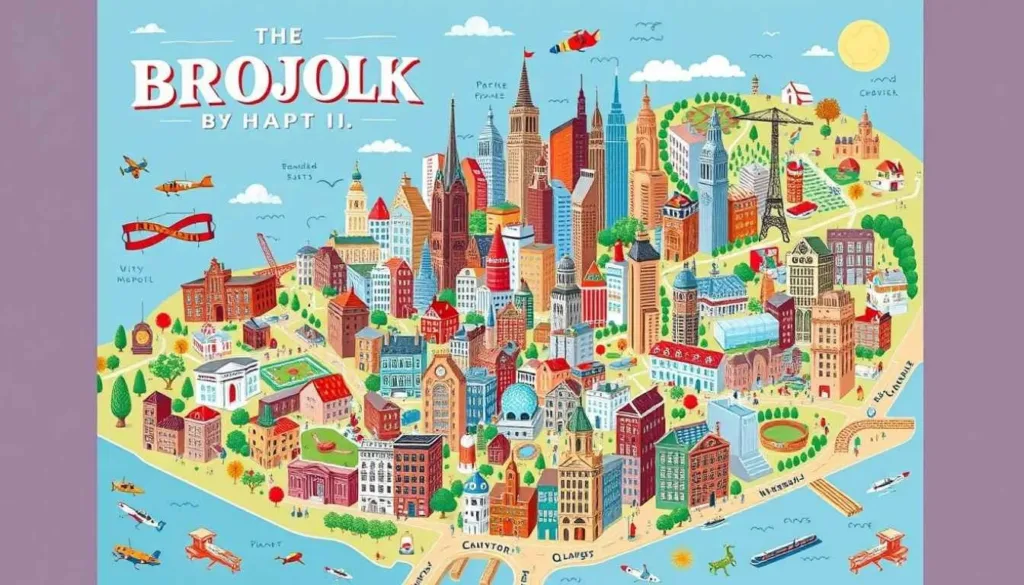
Iconic Neighborhoods: From DUMBO to Bay Ridge
Brooklyn is a borough with many neighborhoods, each unique and rich in history. From the trendy DUMBO to the charming Bay Ridge, these areas define Brooklyn’s vibrant essence.
DUMBO, short for “Down Under the Manhattan Bridge Overpass,” has changed a lot. It was once industrial but now attracts artists, tech companies, and luxury homes. Its views of Manhattan and the Brooklyn Bridge make it a favorite spot for both locals and visitors.
Bay Ridge keeps its local charm and community spirit. It’s known for its beautiful streets, historic homes, and lively business areas. Places like Caroll Street and Third Avenue show the real Brooklyn.
Other notable areas include Flatbush, rich in culture, Williamsburg, the heart of Brooklyn’s art and food, and Crown Heights, celebrating its Caribbean heritage. These neighborhoods make Brooklyn a dynamic and captivating place in New York City.
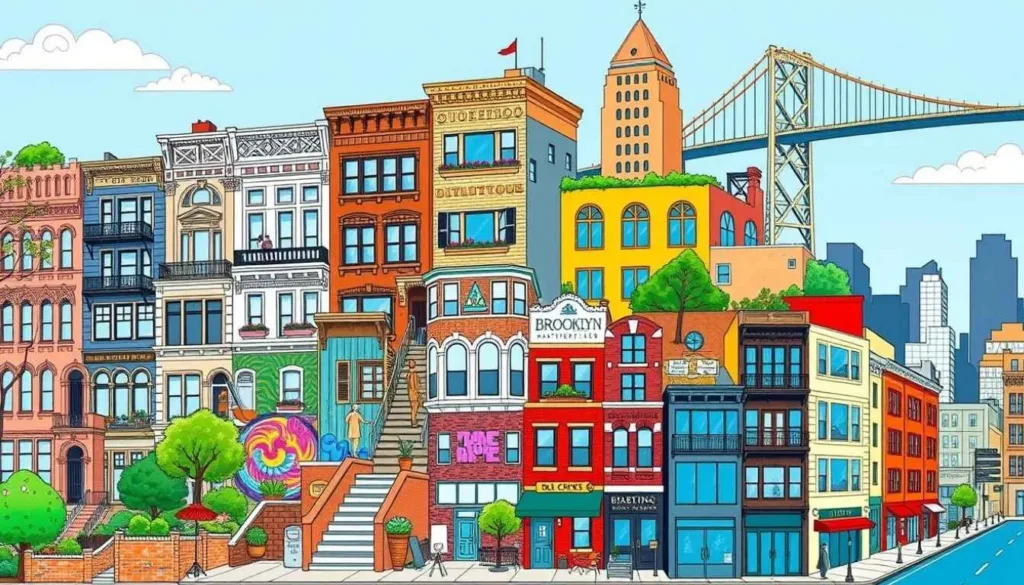
“Brooklyn is the borough that best represents the new face of New York City: young, diverse, innovative, and proud of its history.”
Williamsburg and Bushwick: Arts and Culture Hub
Williamsburg and Bushwick are in the heart of Brooklyn. They have become vibrant arts and culture centers. These areas have changed a lot, from industrial places to places full of art.
Creative Communities and Street Art
These neighborhoods are full of creative people. You’ll find both new and famous artists here. The streets are filled with amazing street art, thanks to local muralists.
People can take tours to see the street art. It’s a chance to learn about the stories and artists behind it. There are also many art galleries, performance spaces, and cultural centers here.
Bushwick Open Studios is a big event. It lets people see where local artists work. It’s a special way to see how art is made in the community.
Culinary Scene and Nightlife
Williamsburg and Bushwick are also known for their food and nightlife. You can find cool cafes, restaurants, bars, and live music venues. There’s something for everyone, whether you love food or music.
The food here shows the area’s diverse culture. You can try everything from ethnic dishes to new food combinations. At night, the area comes alive with music and performances. It’s a place where people from all over come to have fun.
| Neighborhood | Highlights | Popular Attractions |
|---|---|---|
| Williamsburg | Thriving arts scene, trendy culinary offerings, vibrant nightlife | Brooklyn Brewery, The Wythe Hotel, Artists & Fleas market |
| Bushwick | Cutting-edge street art, independent galleries, eclectic dining options | Bushwick Collective, Roberta’s Pizza, House of Yes |
Williamsburg and Bushwick are places of creativity, delicious food, and fun nightlife. They offer a unique experience in Brooklyn’s artistic scene.
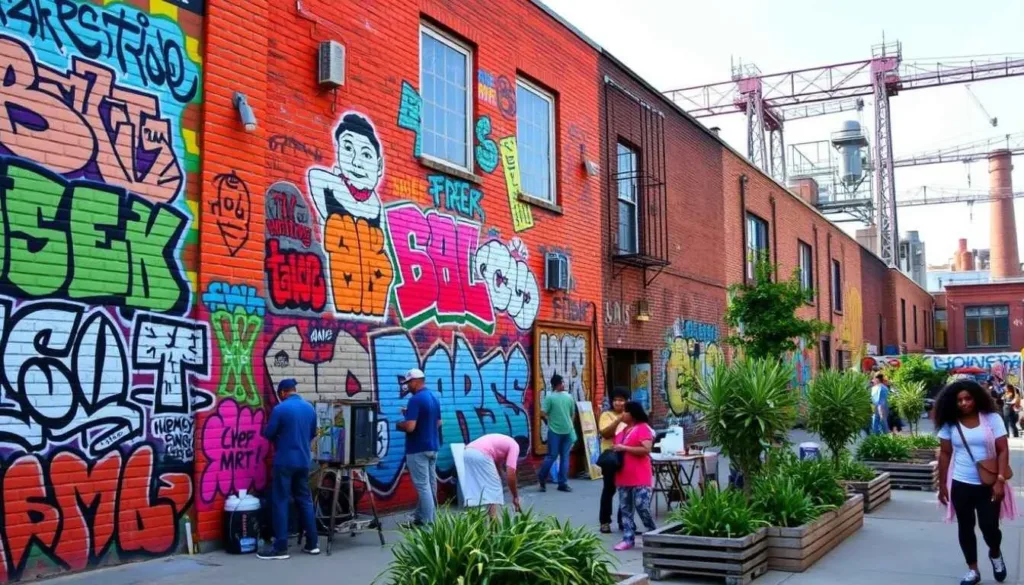
Crown Heights and Prospect Heights: Heritage Meets Modern Life
In the heart of Brooklyn, Crown Heights and Prospect Heights mix history with today’s life. These areas have grown, blending their rich culture with today’s energy.
Crown Heights shows off its past with beautiful old homes. You’ll see brownstones and Victorian houses, telling stories of immigrant communities. Today, the area is diverse, celebrating Caribbean, Jewish, and African-American cultures.
Prospect Heights is known for its arts and food, with Prospect Park at its center. This park, designed by famous landscape architects, is a place for everyone. It has a lake, farmers’ markets, and more, showing the community’s love for green spaces.
In these areas, you’ll find a mix of cultural diversity. Enjoy Caribbean festivals or explore the Hasidic Jewish community. The mix of old and new makes Crown Heights and Prospect Heights special places in Brooklyn.
“The streets of Crown Heights and Prospect Heights show Brooklyn’s lasting spirit. Here, the past and present live together in harmony.”
Walking through these neighborhoods, you’ll see history and modern life together. You’ll find Romanesque Revival buildings, street art, and cool cafes. Crown Heights and Prospect Heights offer a unique experience for everyone.
- Discover the rich cultural diversity in these areas
- See the architectural heritage of old homes
- Enjoy the vibrant arts and dining scene around Prospect Park
- Join in the Caribbean festivals and Hasidic Jewish traditions that define the community
Whether you’re interested in history or modern life, Crown Heights and Prospect Heights are inviting. They offer a place where the past and present meet, making Brooklyn’s heart a fascinating place to explore.
Brooklyn’s Waterfront Transformation
Brooklyn’s waterfront has changed a lot in recent years. It used to be industrial but now it’s full of public spaces and luxury homes. This change has made Brooklyn a different place, both physically and culturally.
Industrial Past to Luxury Present
Brooklyn’s waterfront used to be filled with factories and warehouses. Now, it’s home to fancy condos, top-notch amenities, and high-end shops. This change shows how Brooklyn’s identity has shifted.
The Domino Sugar Factory is a great example of this change. It’s now Domino Park, a lively public area. It offers amazing views of Manhattan and easy access to the water.
Parks and Public Spaces
The waterfront also has many public spaces that people love. Brooklyn Bridge Park is a big 85-acre area along the East River. It’s perfect for fun, relaxation, and cultural events, with great views of Manhattan and the Brooklyn Bridge.
- Visitors can enjoy a variety of amenities, including:
- Lush gardens and playgrounds
- Sports facilities like basketball courts and soccer fields
- Waterfront promenades and piers for leisurely strolls
- The park’s diverse programming, ranging from music festivals to outdoor movies, has transformed the waterfront into a vibrant hub of community and cultural exchange.
Brooklyn’s waterfront makeover has made it a more attractive place to live and visit. It also shows how important public spaces are in cities.
Park Slope and Windsor Terrace: Family-Friendly Communities
Park Slope and Windsor Terrace are in the heart of Brooklyn. They are loved for their family-friendly vibe. Their streets are lined with brownstones, giving a cozy feel away from city noise.
These areas are known for great schools and parks. The Park Slope schools are top-notch, helping kids grow curious. Windsor Terrace has Prospect Park for outdoor fun.
The brownstones here add to the charm. They mix old-world charm with modern living. This makes Park Slope and Windsor Terrace ideal for families wanting a Brooklyn feel.
“Park Slope and Windsor Terrace are the perfect havens for families seeking a community that balances the convenience of city living with the comforts of suburban life.”
| Neighborhood | Median Home Price | Top-Rated Schools | Notable Attractions |
|---|---|---|---|
| Park Slope | $1.4 million | P.S. 321 Brooklyn New School Millennium High School | Prospect Park Brooklyn Botanic Garden Park Slope Food Coop |
| Windsor Terrace | $950,000 | P.S. 154 P.S. 39 Brooklyn School of Inquiry | Prospect Park Green-Wood Cemetery Greenwood Playground |
Transportation Hub: Subway Lines and Connectivity
Brooklyn is the most populous borough in New York City. Its transportation system is key to connecting people to Manhattan and more. The nyc subway is at the heart of this network, making it easy for Brooklynites to get around.
Major Transit Routes
Brooklyn has several major nyc subway lines. These include the A, C, G, 2, 3, 4, and 5 trains. They connect different neighborhoods and key spots. The L train is a big link between Brooklyn and Manhattan, helping many people get to work.
The subway’s wide reach has helped Brooklyn’s neighborhoods grow. Around major transit points, lively communities have formed. These areas are full of shops, restaurants, and attractions for locals and visitors.
Accessibility to Manhattan
Brooklyn’s transport network makes it easy to get to Manhattan. The nyc subway offers quick and direct routes to the city’s center. This lets Brooklynites easily commute, explore, and enjoy what Manhattan has to offer.
This easy access has helped Brooklyn grow. It attracts businesses and people who want a short commute to Manhattan. The connection between Brooklyn and Manhattan boosts cultural exchange and economic opportunities, strengthening their ties.
“The nyc subway system is the lifeblood of Brooklyn, connecting our diverse communities and providing access to the countless opportunities across the river in manhattan.”
Real Estate Trends Across Brooklyn Neighborhoods
As a real estate agent, I’ve seen Brooklyn’s neighborhoods change a lot. Property values keep going up because more people want to live here. Gentrification is making some areas more expensive, affecting long-time residents.
Places like Williamsburg and Bushwick are getting fancier, drawing in young professionals and artists. This has made homes more expensive over the last ten years. On the other hand, Crown Heights and Prospect Heights offer a mix of old charm and new comforts, appealing to families.
The waterfront areas of Brooklyn have also changed a lot. What used to be industrial spaces are now fancy condos and shops. It’s exciting to see how Brooklyn will keep growing and changing.



